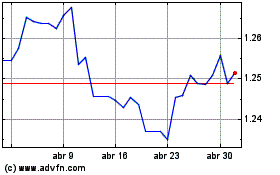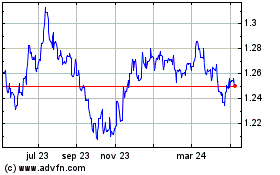German Private Sector Downturn Deepens In September
23 Septiembre 2024 - 1:34AM
RTTF2
German private sector activity fell deeper into contraction in
September with accelerated reduction in manufacturing output, flash
survey results from S&P Global showed on Monday.
At 47.2, the headline HCOB composite output index fell to a
seven-month low in September from 48.4 in August. The score was
forecast to fall moderately to 48.2.
The drag from the manufacturing sector increased as goods output
posted its steepest rate of contraction for 12 months. At the same
time, support to the economy from growth in the service sector
continued to wane.
The services Purchasing Managers' Index fell to a six-month low
of 50.6 compared to 51.2 in the previous month. The reading was
seen at 51.1.
The manufacturing PMI hit a 12-month low of 40.3, down from 42.4
in August. The reading was forecast to remain unchanged at
42.4.
Total inflows of business dropped the most in nearly a year, as
a renewed fall in new work received by services firms coincided
with a deepening downturn in manufacturing new orders. New export
business also decreased on a broad-based basis.
A fall in backlogs of work hinted at decreasing capacity
utilization across the private sector. Job losses were reported for
the fourth straight month.
Increased willingness to trim workforce numbers coincided with a
substantial deterioration in their expectations towards activity in
the coming year. For the first time in twelve months, companies
anticipating a decrease in output over the next year outnumbered
those forecasting a rise.
Turning to prices, the survey showed a notable softening of cost
pressures in September. Input price inflation in the service sector
was the weakest in over three-and-a-half years. Manufacturing
purchasing costs fell at the quickest pace in six months.
There was a slower increase in service sector output prices and
factory gate charges posted an accelerated and solid reduction.
"A technical recession seems to be baked in," Hamburg Commercial
Bank Chief Economist Cyrus de la Rubia said. "Our GDP nowcast for
the current quarter, which considers the HCOB PMI among other
indicators, now points to a 0.2% decrease compared to the quarter
before."
The economy already shrank at a rate of 0.1 percent in the
second quarter. There is still some hope that the fourth quarter
will be better as higher wages combined with lower inflation should
boost not only real income but also consumption, supporting
domestic demand, said de la Rubia.
Sterling vs US Dollar (FX:GBPUSD)
Gráfica de Divisa
De Oct 2024 a Nov 2024

Sterling vs US Dollar (FX:GBPUSD)
Gráfica de Divisa
De Nov 2023 a Nov 2024
